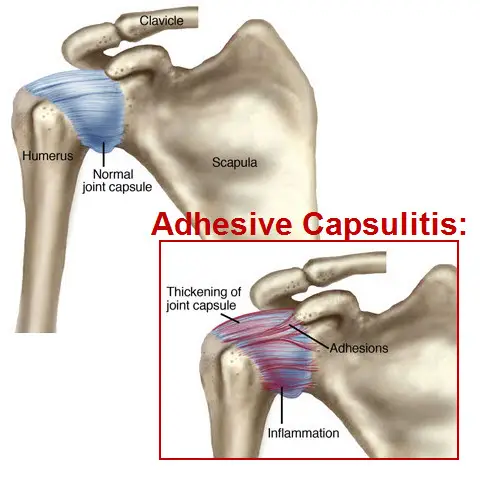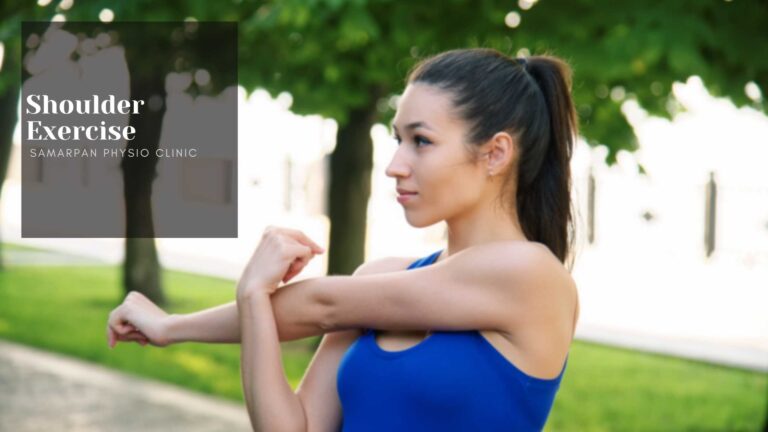22 Best Exercises for Pinch Nerves in the Neck
Experiencing pinched nerves in the neck can be a painful and uncomfortable condition. Engaging in specific exercises can help alleviate symptoms and improve overall neck health.
In this guide, we will explore some of the best exercises designed to relieve neck nerve compression and promote flexibility and strength in the affected area. However, it’s essential to consult with a healthcare professional before starting any exercise regimen to ensure it’s safe and appropriate for your specific condition.
Introduction:
The phrase “pinched nerve” refers to a specific kind of harm or injury to a nerve or group of nerves. When a nerve is under “compression” (pressure), it becomes pinched. Possible causes of the pressure include repetitive motions. Alternatively, it could result in keeping your body still for extended periods of time. There are several modest physical activities you can take to relieve the pain and suffering of a pinched nerve, including side bends, walking, yoga, and neck tilts.
The most effective pinched nerve stretches for your problems might be shown by a physical therapist. However, simple workouts can help to reduce minor pain. Stretching the neck muscles and relieving pressure on the nerve are the main goals of these motions. Perform these exercises slowly to avoid damaging your nerves. They can be carried out either sitting or standing.
Neck pain from a pinched nerve can be excruciating. However, some therapies can help reduce pain and relieve pressure on the nerve, such as physical therapy and immobilizing the neck. The following signs of a pinched neck nerve include neck discomfort, tingling, or numbness in the hand and arm lack of sensation in the arm or hand, or in all three, weakness in the shoulder, arm, or both.
There are several exercises and stretches that can help ease the pain associated with a pinched nerve. The best treatment for a pinched nerve is frequently a combination of exercises, stretches, and posture adjustments because they can lessen symptoms. Your primary methods for treating your cervical radiculopathy should be exercise and posture modification, reestablishing normal neck motion, enhancing strength and posture, and providing you with a self-care plan as part of rehabilitation for a pinched nerve.
The following advantages of performing neck pinch nerve exercise include:
Following are some benefits of routine exercise.
- Increases the effectiveness of daily exercise
- Boost your balance or posture.
- Relaxing the muscles
- Minimizes discomfort
- Become more agile.
- Become more adaptable.
- This enables it to strengthen weak muscles.
- Let go of any tightness or tension.
- You can regain your mobility by exercising.
- Improving coordination.
- Improve your balance.
The best training exercises for neck pinch nerves are listed below:
Chin Tuck
- Start by sitting or standing straight and focusing your eyesight in one spot across the room.
- Put your index finger on your chin to assist in directing your actions.
- You should gently tilt your head back until it is completely horizontal while tucking your chin into your neck.
- Instead of bending your head down to stare at your toes, the movement should result in a double chin while maintaining a straight line of vision.
- After that, revert to your neutral position.
- Then relax.
- 5–10 times per day.
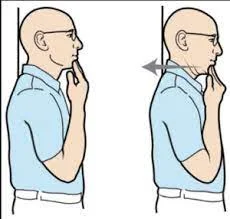
Levator Scapula Stretch
- Maintain a straight posture while standing up, and keep your shoulders back.
- With the elbows bent, raise the arm to 90 degrees.
- Look at the underarm region.
- Grab the back of the head with the same arm.
- Keep the stretch for a short while.
- Return to your neutral position after that.
- Then relax.
- Repeat daily 5–10 times.
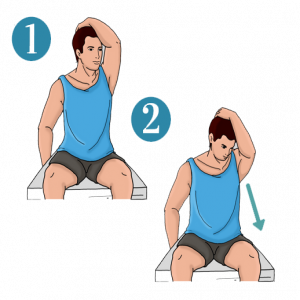
Median Nerve Slider
- Adopt a straight posture while standing up, and keep your shoulders back.
- In order to make a 90-degree angle, raise the shoulder.
- Open out the elbow first before going to the wrist as you extend the entire arm out to the side.
- Feel the stretch in your hand’s palm.
- If doing so makes you more at ease, try opening up the neck by tilting your head in the opposite direction.
- Keep stretching for a short period of time.
- After that, revert to your neutral position.
- Then relax.
- Repeat 5–10 times each day.
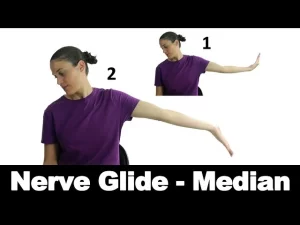
Quadruped Cat-Cow
- Start out on your hands and knees on the ground in the tabletop position.
- Keep your back straight.
- Maintain your hands and feet firmly planted on the surface of the ground.
- Inhale, then raise your head and let the air fill your lungs.
- Hold this position for a short while.
- Exhale and raise your spine upward while tucking your chin into your chest.
- Your lower back begins to somewhat ache.
- Hold this position for a short while.
- After that, revert to your neutral position.
- Then relax.
- Through this exercise 5–10 times.
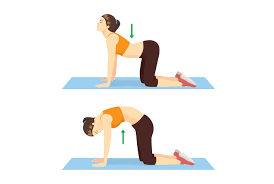
Side bends
- Start with a relaxing standing position.
- Maintain a straight neck and head.
- Without allowing the body to bow forward or backward, progressively lean to the right, followed by the left.
- For a brief period, maintain this posture.
- Return to your neutral position after that.
- Then relax.
- 5 to 10 times through this exercise.
- Add hand weights for a tougher exercise.

Shoulder rolls and shrugs
- Standing up, start the exercise with your feet flat on the floor.
- Shoulder width should separate your feet.
- Turn your palms towards one another while holding your arms at your sides.
- If you’re using weights for the exercise, stoop down and collect them right away.
- Keep your neck straight, your chin high, and your eyes straight ahead.
- Bring your shoulders as high up towards your ears as you can while inhaling.
- Move slowly so that you can feel your muscles’ resistance.
- Return to your neutral position after that.
- Then relax.
- 5 to 10 times through this exercise.

Child’s Pose
- Kneel on your mat with your feet together behind you and your knees wider than hip-width apart.
- Sit back (as best you can) on your heels while folding forward with your tummy resting on your thighs.
- Put your arms in front of you while you lay your head down on the floor.
- The muscles in your neck and back will feel the stretch as well as your hips and glutes.
- Gently press your shoulders and chest towards the floor to increase the stretch.
- Hold this position for a short while.
- After that, revert to your neutral position.
- Then unwind.
- Through this exercise five to ten times.
Twist
- Putting your feet flat on the floor and your back straight, take a seat on a cozy chair.
- Slowly twist to the left side.
- For five seconds, maintain the stretch.
- Then pivot to face forward once more.
- Return to your neutral position after that.
- Then relax.
- Repeat on the opposite side.
- 5 to 10 times throughout this exercise.

Head turns
- In a neutral stance, either sit or stand, turn your face to the side, and glance over your shoulder.
- Take a 5-10 second hold.
- Restore the head to its previous posture.
- Now relax.
- Once more, rotate it to the opposite side.
- Through this exercise five to ten times.

Trapezius stretch
- Start by finding a comfortable seat.
- Place your left hand on your head’s right side.
- Use light pressure.
- Put pressure on your shoulder with your head down.
- For 20 to 30 seconds, hold.
- Then take up the Neutral posture once more.
- Now relax.
- Switch to the opposite side.
- Repeat 5 -10 times this exercise per side.

Chair Stand
- Take a seat in a cozy chair.
- Put your feet flat on the ground while keeping them close together.
- Take a straight seat and contract your abdominals.
- Exhale deeply before slowly rising to your feet.
- Slowly and deliberately lower yourself back down.
- Then return to the Neutral position.
- Now relax.
- Perform this exercise 5 to 10 times.
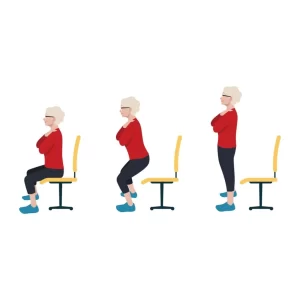
Range of Motion Neck Stretch:
- Start with relaxing seating or standing position.
- Hold the stretch while softly tilting your head back while standing up straight.
- After that, tilt it forward, to the left, then to the right.
- Move softly as you shift into each position and make sure your tilts are mild rather than excessive.
- Then take up the Neutral posture once more.
- Now relax.
- Do this five to ten times.
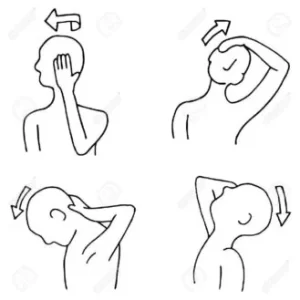
Chest expansion
- While standing, place an exercise band, strap, or piece of fabric behind your back.
- As you extend your shoulder blades towards one another, expand across your chest.
- Turn your head towards the heavens while lifting your chin.
- Up to 30 seconds can be held.
- Then take up the Neutral posture once more.
- Now relax.
- Through this exercise five to ten times.

Isometric Neck Strengthening
- With the addition of resistance, this is similar to the Range of Motion Neck Stretch.
- Put the heel of one hand on your forehead while sitting.
- Allow your hand to gently resist you as you gently press your forehead against it.
- Keep your head from pushing the hand back.
- Hold for ten to fifteen seconds.
- To extend and strengthen your neck on all sides, repeat the exercise with your hand on the left side of your head, pushing against resistance as you move in that direction, then the right side, and lastly the rear of your head.
- Afterward, assume the Neutral position once more.
- Now relax.
- Do this five to ten times.
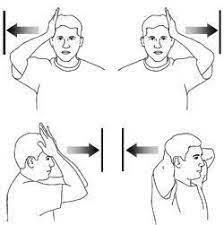
Ulnar Nerve Slider
- Start in an upright position with an appropriate posture, the same as before.
- With your fingers, form the letter “O.K.”
- Slowly raise your arm, extend your elbow out to your side, and lay your three fingers on
- Your jaw without making the ‘O.K’ sign.
- Bone, which is located directly outside of the chin.
- Next, point the “O” portion of the sign with your fingers towards the direction of your eye.
- Once more, this should cause you to feel a stretch in your elbow and possibly in your ring and pinky fingers.
- Perform strictly within a comfortable range, just like with the prior exercise.
- Through this exercise five to ten times.
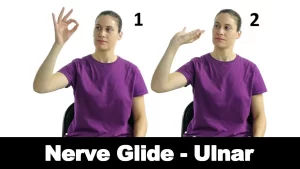
Standing to Pull Apart
- Start out by assuming a proper stance.
- Lock your elbows behind you as you slowly extend your arms behind your body.
- The intermuscular muscles between your shoulder blades should feel tight.
- Don’t venture beyond your comfort zone.
- While some muscular aches or burning is OK, arm or neck pain is not.
- Avoid shrugging your shoulders away from your ears.
- After that, revert to the Neutral posture.
- Now relax.
- Through this exercise five to ten times.
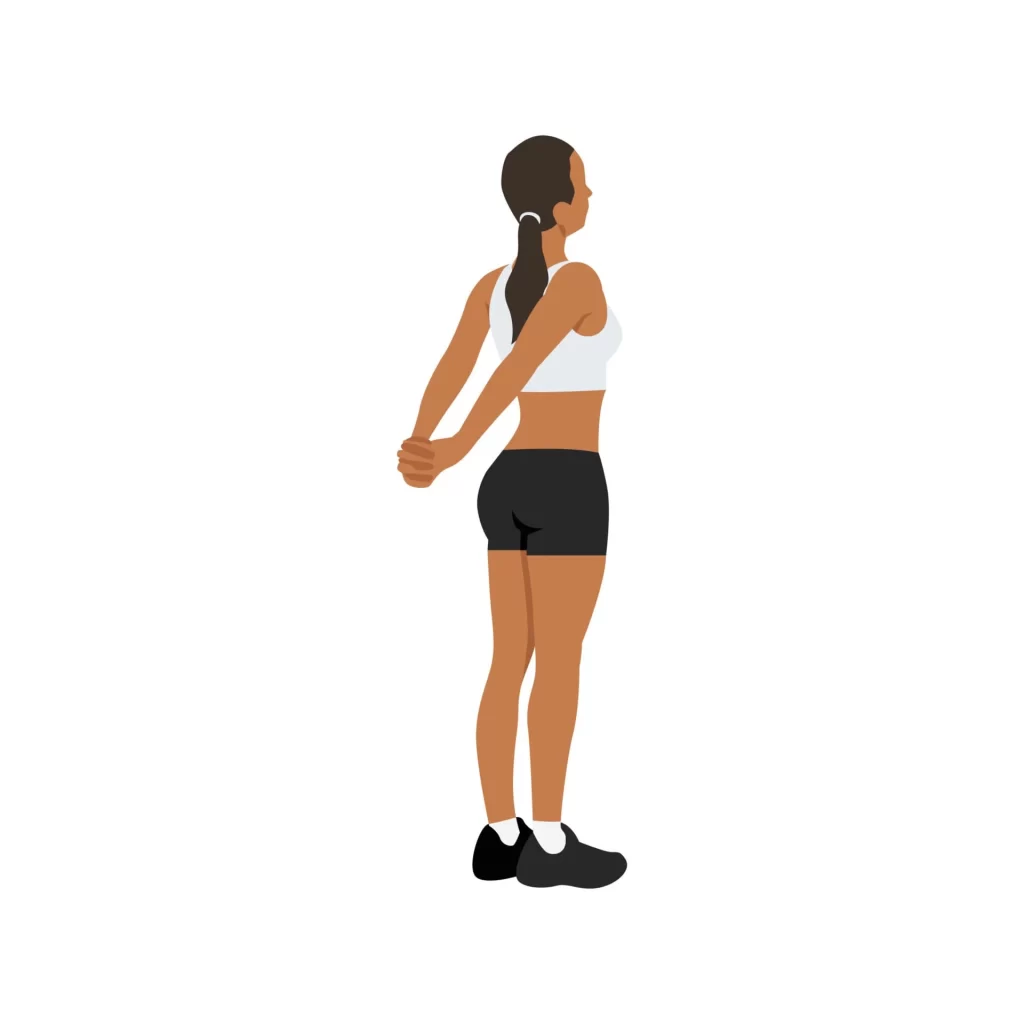
Downward-Facing Dog
- Start out on all fours.
- As you lift your hips high and point your hip bones upward, tuck your toes.
- Avoid letting your heels plank on the floor as you reach your heels back towards the mat.
- Your neck should be lengthy when you droop your head.
- Make sure your wrist creases remain parallel to the mat’s front edge as you remain in this position.
- Press into the knuckles of your forefingers and thumbs to release the strain on your wrists.
- At least three full breaths should be taken here.
- Then let go.
- Go back to being neutral.
- Then relax.
- Do this 5 to 10 times.
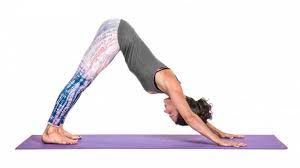
Sphinx Pose
- Rest on the surface of your stomach with your legs outstretched straight back.
- Holding your forearms on the ground and your elbows tucked under your shoulders, raise your chest off the ground.
- Press your hips and thighs into the ground and try to lengthen your spine while keeping your shoulders relaxed.
- Just change the height to ensure that your lower back is adequately stretched.
- Do not exert yourself too far and stop as soon as you feel any pain or distress.
- For at least 30 seconds, hold.
- Return to being impartial.
- Then relax.
- Repeat this 5–10 times.
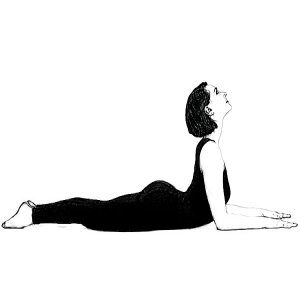
Standing row exercises
- Hip-width apart, tall back, straight hips, and slightly bent knees are the proper posture for standing.
- Attach two handles to the cable pulley, and set it at about chest height.
- Hold one handle in each hand, thumbs pointing to the ceiling, and palms facing each other.
- Lift the chest and pull the rope back while maintaining the elbows close to the sides and the arms parallel to the floor.
- For at least 30 seconds, hold.
- Return to being impartial.
- Then relax.
- Repeat this exercise routine 5–10 times.
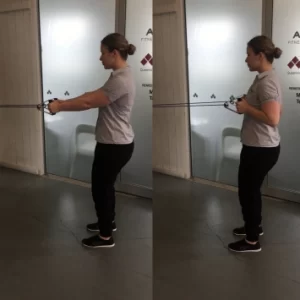
Forward bending
- Start with a comfortable seated position.
- Forward head lowering towards the chest with a brief hold.
- Raise your head gradually until it is in a neutral position.
- Then rest.
- Repeat this exercise 5-10 times.
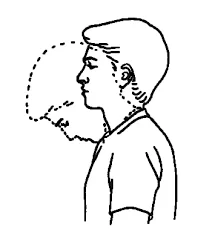
Lateral raises
- Put a weight in each hand as you stand with your feet shoulder-width apart.
- The arms should be extended until they are level with the shoulders while the body remains stationary.
- Hold this position for a few seconds.
- Return the arms to the sides gradually.
- Then return to your neutral position.
- Then relax.
- Repeat this exercise 5-10 times a day.
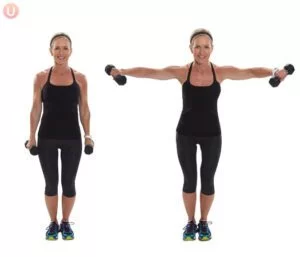
Supine Chin Tuck
- While resting on your back, tuck your chin, but don’t glance down towards your chest.
- From here, carefully raise your head 3 to 4 inches off the floor or bed (or whatever surface you’re on).
- Shortly after five seconds were spent in this position.
- Return to your neutral position.
- Then relax.
- Through this exercise five to ten times.
- Keep your breath steady while performing this motion.
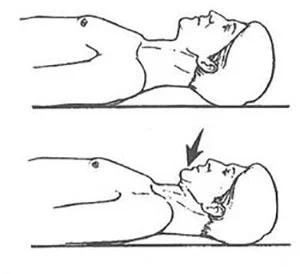
What safety measures are necessary when exercising?
- Before working out, warm up and gently stretch.
- Maintain a straight spine while working out.
- Prevent rigorous physical activity
- Stop exercising if a sudden ache strikes.
- Between exercises, rest.
- Remain hydrated.
- Stretch a little and bend your neck a little.
- Be careful not to jerk your neck.
When do you stop working out?
- Severe muscular ache
- You’re contagious.
- If there is any discomfort or numbness.
- Fever
- Headache
- Exercise should be stopped if it hurts.
What should I avoid doing if I have neck pain from a pinched nerve?
- Exercises, stretches, and other activities that cause more than a little discomfort should be stopped.
- Pushing yourself will simply exacerbate a pinched nerve.
- Furthermore, cease immediately if your arms or hands begin to tingle or feel numb.
- Avoiding exercises that put a lot of strain on your neck.
- Exercises like sit-ups, pull-ups, push-ups, and even bridges are among these to avoid.
- Although straightforward, conventional, and frequently practiced, these exercises might strain the neck muscles and make your neck pain worse.
FAQs
Is a pinched nerve helped by exercise?
An effective technique to relieve the pain of a pinched neck nerve is through exercise. Your posture may change to assist in pain relief, your movement becomes more fluid, and more room is made for an irritated nerve to move by strengthening and extending the appropriate muscles.
pinched
What safe exercises may I do if my nerve is pinched?
Shoulder rolls.
Child’s Pose.
Twist.
Neck tilts.
Head turns.
Forward bending
Ulnar Nerve Slider
What is the duration of a pinched nerve?
During 6 to 12 weeks of receiving preventative therapy, symptoms frequently go away and nerve function returns to normal. Physical therapy and non-steroidal anti-inflammatory medicines (NSAIDs), such as ibuprofen, are examples of conservative treatments.
How effective is stretching for a pinched nerve?
Simple stretches can occasionally provide instant pain relief. The most effective stretch for pinched nerves and back discomfort is The child’s posture stretch is the simplest to execute. In yoga, this stretch is a well-liked resting position. Begin by getting down on your hands and knees, which is essentially being on all fours.
How can I exercise while safeguarding my neck?
Injuries to the neck can be avoided by keeping the spine neutral and employing the appropriate muscles when engaging in a particular exercise, such as weightlifting. If your neck starts to hurt, stop and adjust your form.
How often should someone get pinch neck ache when exercising?
Exercises for neck discomfort caused by a pinched nerve can be performed daily for at least 30 to 35 minutes. You can help yourself relieve discomfort by following a simple daily workout and stretching routine.
What types of exercises can you perform at home to treat neck pinch nerve pain?
Median Nerve Slider
Quadruped Cat-Cow
Side bends
Shoulder rolls and shrugs
Trapezius stretch
Head turns
Lateral raises
Did physical activity help a pinched nerve?
An effective technique to relieve the pain of a pinched neck nerve is through exercise. Your posture may change to aid in pain relief, your movement becomes more fluid, and more room is created for a pinched or irritated nerve to move by strengthening and stretching the appropriate muscles.
How are pinched nerves avoided?
Maintain proper alignment; avoid crossing your legs or staying in one position for an extended period of time.
Include strength training and flexibility exercises in your everyday exercise program.
When doing repetitive tasks, keep them to a minimum and take frequent pauses.
keep a healthy weight.
What should a pinched nerve sufferer avoid doing?
Exercises, stretches, and other activities that cause more than mild discomfort should be stopped. Pushing yourself will simply exacerbate a pinched nerve. Moreover, if your arms or hands begin to tingle or feel numb, stop. Avoiding exercises that put a lot of strain on your neck can also be beneficial.
How does a pinched nerve help you restore strength?
Consider low-impact aerobic exercise after some moderate stretching, such as walking, cycling, or swimming. These exercises will improve blood flow to the injured nerve, promoting healing and lessening the agony brought on by a pinched nerve.
What treatment method works best for a pinched nerve?
The most frequently recommended treatment for a pinched nerve is resting the affected area. Any activities that create the compression or make it worse will need to quit, as instructed by your doctor. Depending on where the pinched nerve is, you might need to immobilize the area with a brace, collar, or splint.
How does one manage a pinched nerve?
When treating a pinched nerve, it’s important to avoid overusing the nerve. Overuse can exacerbate nerve injury. It’s vital to keep the nerve from being overused when treating a pinched nerve. Additionally, they ought to make an effort to sleep in a position that releases pressure from the nerve.
What actions aggravate the nerve?
A pinched nerve can develop as a result of constant activity and repetitive movements. Particularly for those who perform manual labour, this is a possibility. A nerve can also get constricted under the strain of constant twisting, tugging, moving, and lifting.



